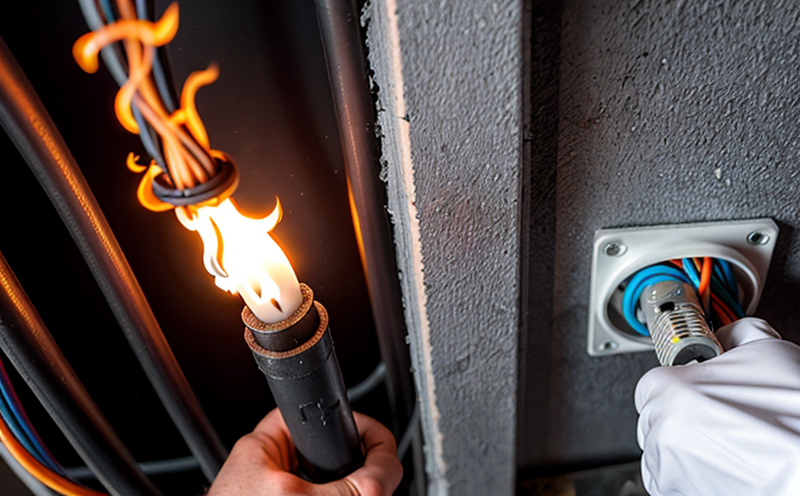Horizontal Burn Testing of Cable Jackets
The horizontal burn testing of cable jackets is a critical procedure in fire safety testing. This test evaluates how well the jacketing material resists flames and prevents the spread of fire when exposed to an open flame source. The primary purpose is to ensure that cables can withstand accidental ignition, minimizing potential hazards associated with electrical installations.
The process typically involves placing a sample of cable jacketing on a horizontal surface and exposing it to a controlled flame for a specified duration. The flame is then removed, and the tester observes the behavior of the material as it burns or extinguishes itself. This test helps identify materials that could potentially contribute to rapid fire spread in the event of an ignition source.
Several factors influence the outcome of this testing:
- Type of Flame Source: Commonly, a Bunsen burner is used for its consistent and predictable flame. The standard flame height is set to ensure uniformity across tests.
- Duration of Exposure: Typically, the exposure lasts 5 seconds after which the flame source is removed. This duration ensures that any flame retardant properties are tested under controlled conditions.
- Specimen Preparation: Samples are cut into standard sizes and shapes to ensure consistency in testing. The edges of the specimens may be trimmed for uniformity.
- Measurement Criteria: Key parameters include the rate at which the flame propagates along the specimen, whether it drips or melts, and the time taken for the fire to extinguish once the flame source is removed.
The test results are essential for ensuring compliance with various international standards such as ISO 13943-2:2017 and ASTM E84-21. These standards provide detailed guidelines on the setup, execution, and interpretation of horizontal burn tests. Adherence to these standards ensures that fire safety regulations are met across different jurisdictions.
In addition to compliance, this testing plays a crucial role in product development for electrical and electronic equipment manufacturers. By identifying materials with superior flame resistance, companies can enhance the safety features of their products. This is particularly important in sectors like telecommunications, construction, and aviation where fire safety is paramount.
The results from horizontal burn tests are used to determine the flame spread index (FSI) or smoke density rating (SDR). These metrics provide a quantitative measure of the material's performance under fire conditions. A lower FSI indicates better flame resistance, while a lower SDR suggests minimal smoke production during combustion.
Understanding these metrics is crucial for quality managers and compliance officers responsible for ensuring product safety. For R&D engineers, this testing provides valuable data on material selection and formulation. By analyzing the results of multiple tests, they can refine their designs to achieve optimal flame resistance without compromising other critical performance attributes.
Applied Standards
The horizontal burn test for cable jackets is governed by several internationally recognized standards that provide precise instructions on how the test should be conducted. These include:
- ISO 13943-2:2017: This standard specifies the procedure for conducting a horizontal burn test, including specimen preparation and flame exposure duration.
- ASTM E84-21: Known as the "Stepping Cone Test," this standard details how to measure flame spread and smoke production using a standard flame source.
These standards ensure consistency across tests conducted by different laboratories, thus facilitating accurate comparisons of results. Compliance with these standards is essential for manufacturers looking to meet regulatory requirements and market demands.
Scope and Methodology
The scope of horizontal burn testing encompasses a variety of cable jacket materials used in different applications. This includes:
- PVC (Polyvinyl Chloride)
- XLPE (Cross-linked Polyethylene)
- Elastomeric compounds
The methodology involves several key steps:
- Specimen Preparation: Samples are cut into standard sizes and shapes.
- Flame Exposure: The samples are exposed to a controlled flame source for 5 seconds.
- Data Collection: Observations include the rate of flame spread, drip behavior, melt characteristics, and time to extinguish.
The data collected during these tests is then analyzed against specified acceptance criteria. Any deviations from acceptable standards may indicate potential hazards in the application environment.
Competitive Advantage and Market Impact
Incorporating horizontal burn testing into product development strategies offers significant competitive advantages:
- Enhanced Safety Features: Meeting or exceeding fire safety standards can enhance brand reputation and consumer trust.
- Regulatory Compliance: Ensures adherence to international regulations, thereby avoiding costly penalties and legal issues.
- Innovation Opportunities
The results of these tests also have broader market impacts:
- Improved Product Reliability: By identifying and addressing potential fire risks early in the design process, companies can enhance product reliability and performance.
- Increased Market Share: A reputation for high-quality, safe products can lead to increased sales and market share.
In conclusion, horizontal burn testing is a vital component of any comprehensive approach to fire safety. Its role in ensuring product safety, compliance with regulatory standards, and fostering innovation cannot be overstated.





